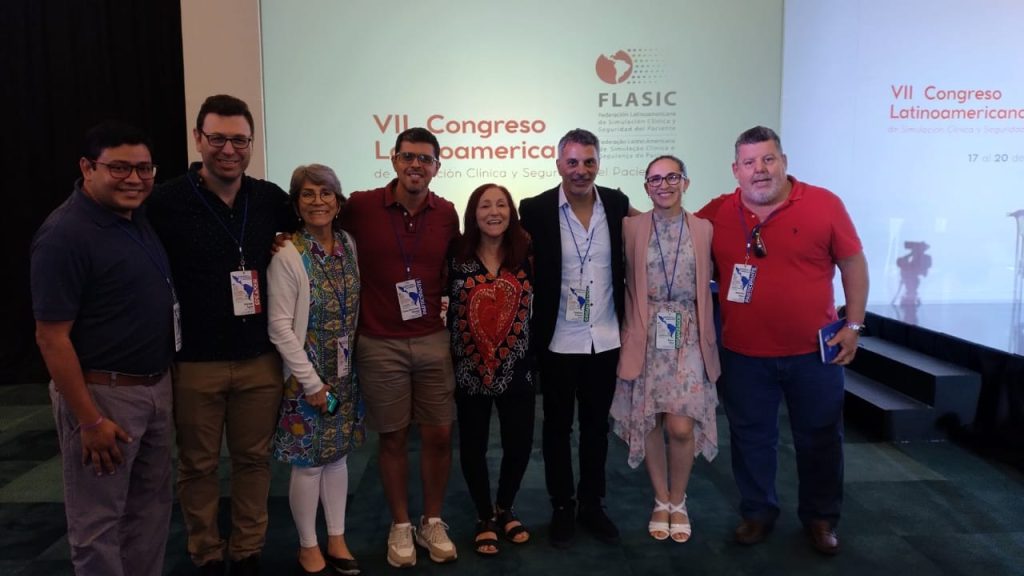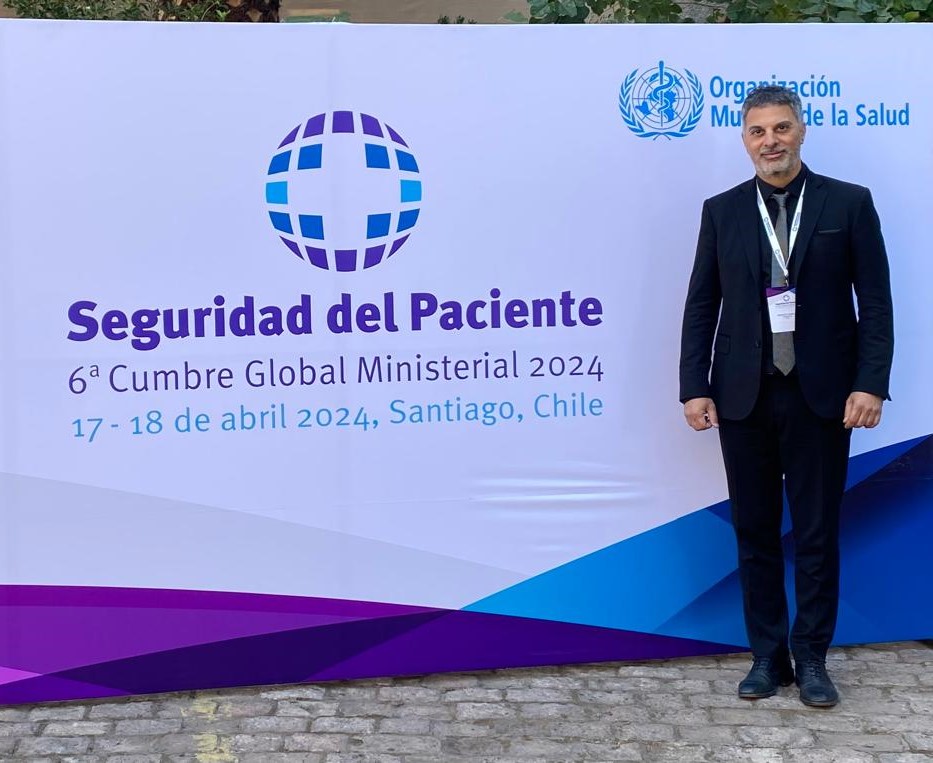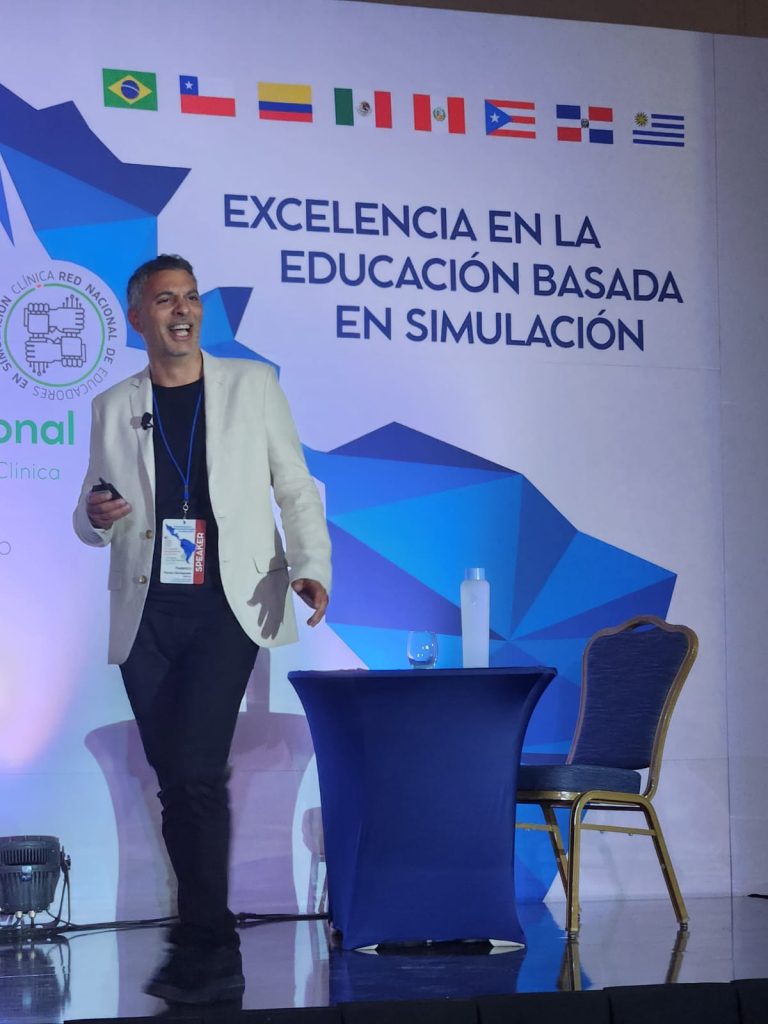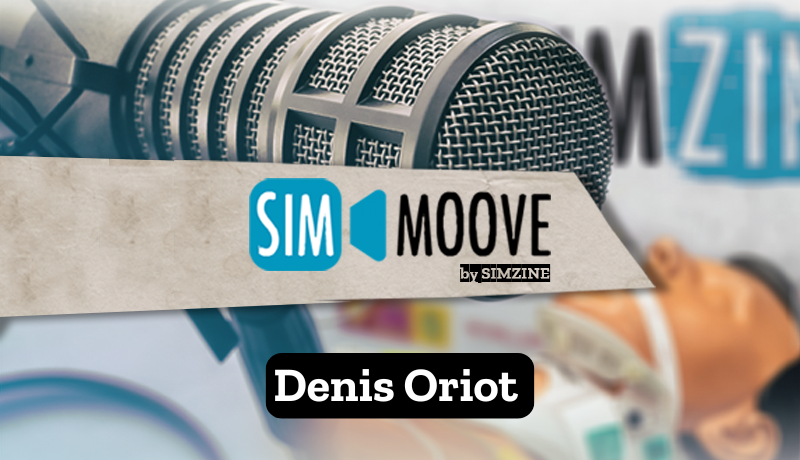Federico Ferrero is not a healthcare professional, but has worked in healthcare for more than 10 years. With a career of two decades training teachers and professors, he has excelled in the field of clinical simulation in Latin America. Not only does he teach, but he is also dedicated to learning, researching and managing innovative educational projects. Despite not being a professional pilot, his passion for aviation has given him a unique perspective on safety and simulation, areas in which he has applied his creativity and ability to face challenges. As President of the Latin American Federation of Clinical Simulation and Patient Safety (FLASIC), Federico leads a collaborative network that seeks to improve healthcare education and patient safety in the region. His enthusiasm for collective projects and his commitment to education are reflected in each of his initiatives, inspiring many in the field of clinical simulation.
Hello Federico, thank you for taking the time to join us. It is an honor to chat with the President of the Latin American Federation of Clinical Simulation and Patient Safety (FLASIC). Can you tell us briefly about yourself and how you started working with simulation in healthcare?
Hello, thank you for the invitation. I discovered clinical simulation in 2011, finishing the fifth (and last) year of a full-time research grant that I had been awarded by the National Council of Science and Technology of Argentina (CONICET). While I was writing my doctoral thesis and wondering what direction to give to my professional career, I received a call from the Faculty of Medical Sciences of the National University of La Plata (where I still work today as a professor), offering me to join the teaching team of the recently inaugurated Clinical Simulation Hospital of the institution. I had never heard anything, until then, about teaching based on clinical simulation. I found it a new and absolutely fascinating world, especially because of the enthusiasm it generated in the students. I remember thinking: this is going to revolutionize everything. In those years clinical simulation was something recent in Argentina, even disruptive, and there was some mistrust regarding its usefulness. In 2016 I traveled to visit the Simulation Center of the Faculty of Medicine of the UNAM in Mexico, and there, at a Congress of the Mexican Association of Faculties and Schools of Medicine (AMFEM), I met FLASIC.
Can you explain to our readers what exactly FLASIC is, from your point of view?
FLASIC is the Latin American Federation of Clinical Simulation and Patient Safety , a non-profit organization created in 2007 (originally named ALASIC), with the mission to promote clinical simulation-based education in Latin America . We try to give a general framework to the initiatives of each organization specialized in clinical simulation in our region. To this end, we build collaborative networks that, by virtue of working together, contribute to amplify the potential of each of our partners and institutions. Our motto is “if you are not there, we are not all there”.
Today FLASIC has a management team in which I am accompanied by Latin American educators with extensive experience, very committed to the collective improvement of our teaching practices based on clinical simulation. They are: Sara Morales (Mexico), Alessandra Vaccari (Brazil) and Álvaro Prialé (Peru).

Why a federation of national societies? What is the advantage?
The advantages are those of teamwork. Latin America is the most unequal region in the world, with little investment in research and development in relative terms. However, the specificity of our countries is not only expressed in these limitations, but in a set of qualities that characterize the professionals of our countries: resilience, creativity, imagination, ability to innovate and manage uncertainty and above all, I believe, the ability to work in partnership.
In this context, the role of a supranational association such as FLASIC is strategic in building synergy among the multiple nodes of teaching, research and innovation in clinical simulation that exist in each of the countries of the region. In Latin America, these nodes are usually articulated through national clinical simulation societies and/or associations of schools and faculties of medicine and health sciences; hence the relevance of thinking about the figure of a Latin American Federation (or association of associations). Although the societies that make up FLASIC are very different from each other in terms of their history, background, or number of members, we believe it is possible to generate joint policies that enhance their work, without clashing with the strategic projects of each one of them.
You have been on FLASIC’s executive board for several years, how did you decide to offer your services for your current position as President?
I started participating in FLASIC in 2018, when I was invited to join the Online Education Commission, a space that I then coordinated during the pandemic (2020-2021). In 2021, together with Eva Miranda and Alessandra Vaccari, we decided to put together a list and run for the Board of Directors for the period 2021-2023 to accompany Andrés Díaz-Guío , who assumed the Presidency for that biennium. FLASIC’s political system stipulates that whoever is elected Vice-President for a two-year term automatically becomes President for the subsequent term. That 2021, our list was the most voted in the general assembly of members, and therefore I assumed the Vice-Presidency that year and a few months ago, in December 2023, my current role.
I think that beyond the projects included in our Work Proposal, the partners supported our vision of FLASIC, which was expressed even in the name we chose for the list: “More Latin America for Clinical Simulation”. The idea is that our work proposals should be nourished by local and regional advances, with a view to generating knowledge, practices and services in clinical simulation that are specific and contextualized. That is to say, referenced in our educational traditions and our healthcare cultures.

What are the main challenges you will face in your management?
Within the framework of the vision I mentioned, we seek that all aspects related to the professionalization of our activity as educators, technicians and researchers be included in the Federation’s lines of work. One of the most important projects that we are carrying out is the one of accreditation of simulation centers , through a model developed by FLASIC, validated by experts from 12 countries in our region and piloted in 3 Latin American institutions, and which today has 28 institutions that have started the path of self-evaluation of their processes. We are also developing a certification program for teachers and technicians that includes advancing in the definition of basic competencies for the performance of both roles in the Latin American context. We also have the challenge of continuing with our Latin American Journal of Clinical Simulation, and to promote scientific research. We are expanding online educational activities such as workshops, discussions, interviews and symposiums, and everything that allows us to continue learning, teaching and sharing. Finally, we are working to improve our possibilities for collaborative work, building spaces for socialization in which we can meet with other partners and synergy is possible.
You are one of the few simulation societies that has Patient Safety in its name. So, Federico, what specifically is FLASIC doing to increase the safety of Latin American patients through the use of simulation?
We carry out different initiatives. The most concrete action is undoubtedly related to the training of healthcare professionals in those aspects of their performance that have a direct impact on patient safety, following the precepts of the 6 International Goals defined by the WHO. However, we know that improving patient safety in Latin America implies not only working with healthcare teams but also building a new culture of safety that also involves patients and their families.
Within this framework, FLASIC regularly holds an International Symposium on Clinical Simulation and Patient Safety, which is an activity that was born in 2019 and is completely virtual and open to the community of health science educators in Latin America. The space has a rapidly growing appeal, and has been incorporating the voices of health careers students and patients. This year, in September, the fourth consecutive edition will be held.
We also develop joint activities with different associations working towards patient safety, some of them linked to clinical simulation-based teaching, but not in all cases. An example of this work is the international seminar that culminated in the Declaration of Rio de Janeiro (2023). The event brought together a group of civil associations and state institutions concerned with the education of health technical personnel in the region. During the seminar, not only was a document with guidelines prepared, but teams were formed and a joint work schedule for the current year was drawn up.
Given the multiple and similar challenges we face in most countries, what are we doing wrong? What are we lacking? Where should we be aiming for?
I understand that each region has its particularities and priorities. However, if I were to make a list of common challenges I would include the development of interprofessional simulation; the integration of clinical simulation-based teaching into health care systems; and the incorporation of clinical simulation and patient safety into the regular curriculum planned for undergraduate and graduate training of healthcare professionals.
On the other hand, I believe that today it is of utmost relevance to analyze the limits and possibilities of Artificial Intelligence in its incorporation to clinical and educational processes and, in particular, to teaching based on clinical simulation. Undoubtedly, this is one of the great challenges in the short and medium term.
I also believe it is essential to close the existing gap between the theoretical production in medical education and patient safety and the concrete and daily practices of health care. There is a persistent challenge which is that of cultural change, and which is visualized in the difficulty of overcoming the inertia of our professional practices. I mean, while we debate about safety (1.0, 2.0, 3.0), and we fall in love with resilience engineering and proactive proposals in patient safety, we are still far away in some countries and regions from achieving the standardization of basic care processes (alarm guidelines, medication, referral criteria, etc.) and/or complying with elementary safety strategies such as the pre-surgical checklist or patient identification.
In your experience, what are accreditation, certification and credentials for?
I believe that in all cases we are talking about evaluating ourselves and establishing quality standards for our teaching and institutional practices, and this is essential. If there is something that educational theory has shown in the last 20 years, it is that we cannot improve without feedback, without knowing our strengths and weaknesses.
However, we must avoid falling into an “accreditationist” dynamic where, to the extent that the certification of institutions and individuals grants a distinction and a market value to its bearers, obtaining the certificate is valued above the process of personal learning and/or institutional improvement. The challenge is to build evaluation mechanisms that, without underestimating the importance of certifying and auditing the quality of educational processes and services in clinical simulation, emphasize the possibility of improvement and learning, at the individual, institutional and collective levels.
For example, FLASIC is currently designing a program for the certification of teachers in clinical simulation which, although it provides for the award of a certificate to those who demonstrate certain teaching competencies, emphasizes the process rather than the result. It is a program that aims to accompany teachers to identify their strengths and areas for improvement, building from there a self-directed learning path (in which they produce and share evidence) that culminates in the certification of their competencies to teach with clinical simulation. In short, is certification important? Yes, but as a result of a learning process that raises our quality standards, both individually and collectively.

The VI Ministerial Summit on Patient Safety, in which you as president of FLASIC officially participated: can you tell us briefly about that experience?
It was a very interesting experience. I was invited to share FLASIC’s experience in working with other non-governmental organizations to improve patient safety.
Education and training of healthcare professionals is always part of a broader strategy that seeks to improve the quality of our healthcare systems and the safety of our patients. I believe that our professional associations, such as FLASIC or SESAM, have a relevant role in shaping safer healthcare, and that they can really help national states and international organizations such as WHO in this process, through different mechanisms.
One of them is to transfer our experience in the construction of networks that allow the sharing of knowledge, resources and local experiences, with a real impact on patient and healthcare team safety; this is the case of the Rio de Janeiro Declaration that I mentioned earlier. We are also experts in the development and implementation of better education plans and programs for healthcare professionals, as they constitute contextualized patient safety solutions that are tailored to the specific needs of each country, region and locality. In short, we are relevant agents in the promotion and construction of a new patient safety culture, by providing tools and resources to change healthcare attitudes and practices in each region.
I read that you are an aircraft pilot in training. In aeronautical simulation everything is very codified and standardized, why is the same not true in health simulation?
That’s right, I am learning to fly single engine airplanes. To tell you the truth, I am not an expert in aeronautical simulation, although I can tell you about my learning experience in aeronautics and to what extent it has given me tools to think from other angles about teaching based on clinical simulation. What I emphasize most is the central place that operational safety has in pilot training and, in comparison, the marginal place that patient safety has in the training of healthcare professionals. There is a set of non-technical skills such as anticipation, verbalizing out loud, structured and unambiguous communication, use of cognitive aids, etc. that are trained from day one in the aeronautical field. I remember in my first class of the pilot course, the first and last thing I did were checklists.
While the comparison between commercial aviation and healthcare has already been the subject of much research, and it is clear that safety strategies cannot be transferred linearly from one field to the other, it is clear to me that there is in aeronautics an organizational culture of safety that is very present, omnipresent I would say, in all those involved in the activity. And this is something that is still under construction in the field of health. I think then that we have there, in the design of the learning processes of health professionals, even from undergraduate, an aspect to review and that explains in part why the numbers of commercial aviation on adverse events are so good compared to those of health care.
Thank you, Federico, I am pleased to have this space with you; I feel inspired, too, as it has made us reflect on what we do and what we can do in the field of simulation. Before we say goodbye, is there anything you would like to add?
I would just like to thank you for the invitation. I remain at your disposal to continue thinking together on how to improve our simulation-based education practices and our healthcare systems. Congratulations for the work you are doing with this journal, which has been very well received by the Spanish-speaking community of clinical simulation educators. And finally, I would like to ask those readers who want to know about FLASIC and clinical simulation in Latin America to follow our networks. We are waiting for you all because as we say in FLASIC… “if you are not here, we are not all here”!
Thank you very much again for this enjoyable and inspiring talk.
READ ALSO






































